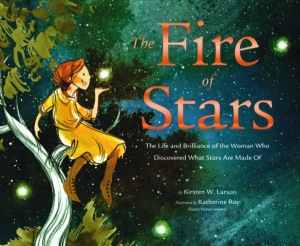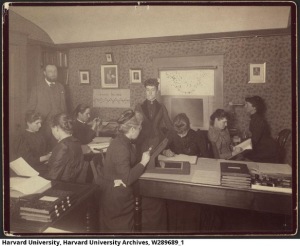Estimated reading time: 4 minutes. (Contains 830 words.)
Primary Audience: Classroom Teachers
A Backstory: In April 2014, I heard the name Cecilia Payne-Gaposchkin for the first time.
Correction: I might have heard her name before, but it lodged in my brain this time. What was different this time?
It’s simple: I watched an episode of the television show Cosmos: A Spacetime Odyssey about Cecilia’s life and work. The program, called “Sisters of the Sun,” detailed the lives of three female astronomers who worked at The Harvard College Observatory more than 100 years ago. Each made amazing – and often uncredited – discoveries about the stars.
That brief introduction to their lives got me wondering: Who were these women? Had someone written about them? What motivated them to continue in an environment where women weren’t considered real astronomers?
Researching the answers led me to write about Cecilia Payne-Gaposchkin in THE FIRE OF STARS: The Life and Brilliance of the Woman Who Discovered What Stars Are Made Of, illus. Katherine Roy (Chronicle Books).
This experience taught me an important lesson: it’s hard to be curious about things you know nothing about. To spark curiosity and wonder, writers must do some reading and research first. A simple story idea – a name or topic – isn’t enough to get the creative juices flowing.
Examining the research: In his research, professor George Loewenstein, author of The Psychology of Curiosity, defines curiosity as a gap between what we know and what we want to know. By definition, we have to know something about our topic to want to learn more. As Loewenstein puts it, we have to “prime the pump” of curiosity.
For writers, we must seek out information that fills us with more questions. I become curious by visiting museums, watching documentaries, and reading nonfiction books and magazines like Smithsonian or National Geographic.
In the classroom
It may be difficult for young writers to get excited about writing informative/explanatory texts or even opinion pieces on topics they know nothing about. That’s why giving them information is critical to help spark their curiosity. They could:
- Read a picture book or short article: Ensure your students have access to a wide variety of exciting and engaging nonfiction books in the classroom. Fellow author Melissa Stewart has wonderful resources for expanding your book collection. For brief nonfiction articles, look to sources like National Geographic Kids.
- Study a photograph, poster, or other visual media: The Library of Congress has interactive discovery sets allowing students to zoom in, highlight, and mark up primary sources on a number of student-appropriate topics.
- Watch a snippet of a documentary: YouTube and PBS.org are great resources. National Geographic Kids has short videos too.
Next, have your students create three columns in their writers’ notebooks. Encourage them to take notes in these three columns as they read, watch, and study.
- “Things I notice:” This is where they will put the most interesting things they notice or learn and any fun and fascinating facts.
- “I wonder:” This is where they will list their questions or things they want to know more about.
- “Where to find out more:” This is where they will brainstorm places to search out answers to their questions. If they are using a nonfiction book to “prime the pump,” guide them to the bibliography or list of where to find more information in the back matter. For photos, have them look at the captions for ideas of where to learn more.
Alternatively, you could work on this as a whole class, creating a “Wonder Wall.” This works especially well for younger students. Project the source on the screen and create three columns on your whiteboard for the whole class to fill in.
Here’s an example of how this process might work. Below is an image from the Harvard College Observatory related to “Sisters of the Sun.” What follows are a few of my notes.
- Things I notice:
- There is only one man.Their clothes make it look like this was long ago.
- The women use magnifying glasses to look at something and taking notes in notebooks.
- I wonder:
- Why are there mostly women? Who is the man?
- When was this photo taken?
- What are the women looking at?
- Where to find out more:
- Harvard archives
What’s Next: Once your students have finished, they’ll have focused areas for their research and a list of places to research. This will guide their research and writing process.
Happy writing!
Kirsten W. Larson used to work with rocket scientists at NASA. Now, she writes books for curious kids. Kirsten is the author of the nonfiction picture books: WOOD, WIRE, WINGS: Emma Lilian Todd Invents an Airplane, illustrated by Tracy Subisak (Calkins Creek), A TRUE WONDER: The Comic Book Hero Who Changed Everything, illustrated by Katy Wu (Clarion), and THE FIRE OF STARS: The Life and Brilliance of the Woman Who Discovered What Stars Are Made Of, illustrated by Katherine Roy (Chronicle), along with 30 nonfiction books for the school and library market. Learn more or connect with Kirsten on Twitter/Instagram @kirstenwlarson or via her website KirstenWLarson.com.
Giveaway Information: You can win an autographed copy of THE FIRE OF STARS by Kirsten W. Larson and Katherine Roy, which was donated by Kirsten Larson. To enter the giveaway, leave a comment about this post by 9/27/23 at 6:00 p.m. EDT. The winner will be randomly selected by Stacey Shubitz and announced at the bottom of the post by 9/30/23. You must have a U.S. mailing address and provide a valid e-mail address when you post your comment. If you win, Stacey will email you for your mailing address. You must respond within five days, or a new winner will be chosen.
Congratulations to Angie whose commenter number was selected. She’ll receive an autographed copy of THE FIRE OF STARS.





Your reminder that curiosity requires some knowledge to build on is really powerful for me. I’ve been thinking a lot about what I can do this year to encourage my students’ curiosity and motivation to follow that curiosity. Thank you for your great suggestions!
LikeLike
Great thoughts putting these wonders in their journals. Making this a habit & sparking their curiosity would help more of our students turn to writing as a way of expressing their wonderings as well as discoveries.
LikeLike
I love the idea of “priming the pump” of curiosity through the use of a wonder wall. This concrete device is a great launch pad for writers.
LikeLike
Thanks so much for chiming in, Debbie! Have a fantastic school year.
LikeLike
Thanks for chiming in, Debbie. Have a wonderful school year!
LikeLike
Your blog continues to be of assitance to my “stars” both young and young at heart. That is solid teaching right there. Thank you for your inspiration. I would also be thrilled with the beautiful book you have offered in the giveaway. I will use it both with my students at Museum Poetry workshops and with my adults.
LikeLike
Best of luck, Linda!
LikeLiked by 1 person
Wonder walls are a genius means for making thinking visible.
LikeLike
Thanks for stopping by, Mary! I’m glad you find wonder walls helpful.
LikeLike
I have a wonder wall in my room, and this will compliment this nicely.
LikeLike
What a wonderful idea!
LikeLike
This will be a wonderful instructional tool to encourage students to notice and wonder. I love the three column chart and/or the wonder wall to support the students.
LikeLike
Thanks so much, Joni. Have a fabulous school year.
LikeLike
LOVE the idea of a Wonder Wall! Thx for the links to resources.
LikeLike
Happy to help, Linda! 🙂
LikeLike
Oh wow I love this so much! I worry with the rise of scripted curriculum that we might lose the intellectual curiosity component that’s necessary for learning and development. This is a beautiful way to infuse that.
LikeLike
Thanks, Nora. We definitely don’t want kids to lose their sense of wonder and curiosity. We need it to develop future creatives, scientists and engineers, and all-around wonderful humans.
LikeLike
I love this idea. Thanks for sharing ways to inspire wonder.
LikeLike
You’re welcome, Destiny. Thanks for stopping by!
LikeLike